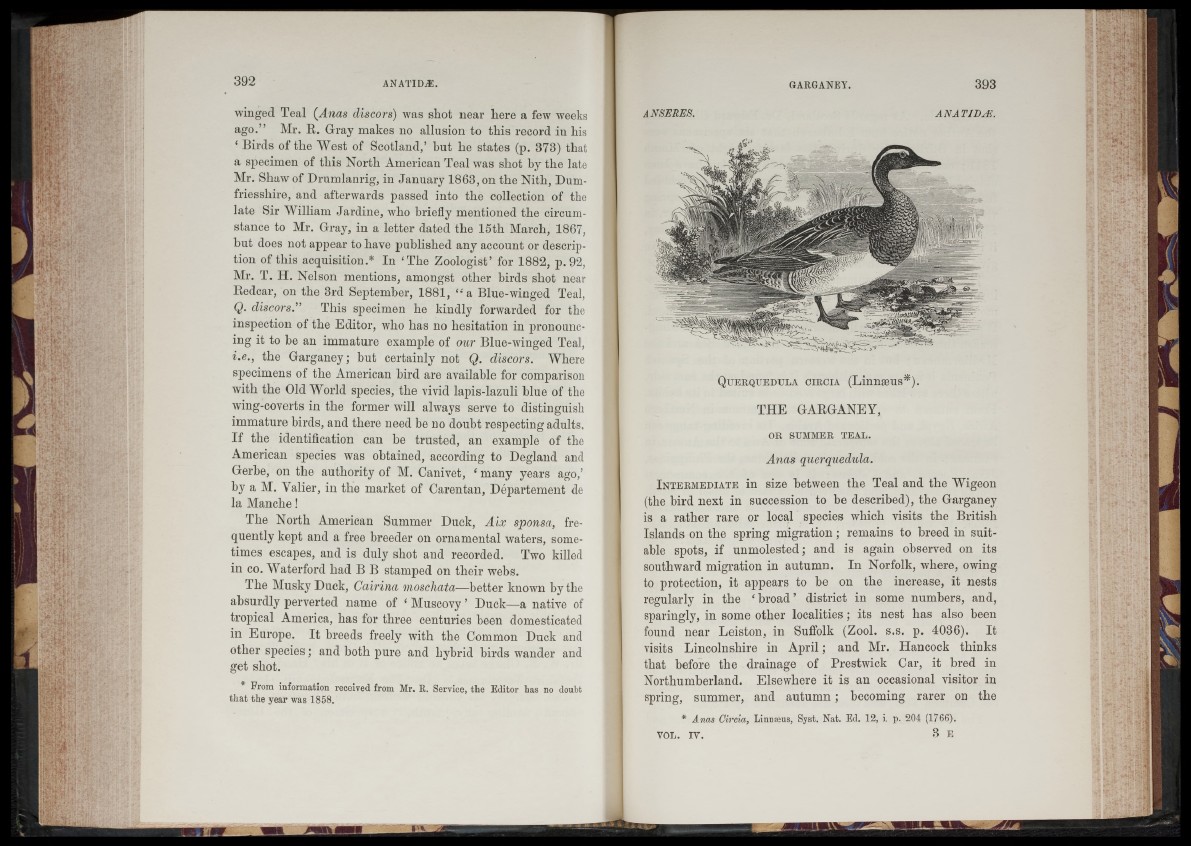
winged Teal (Anas discors) was sliot near here a few weeks
ago.” Mr. R. Gray makes no allusion to this record in his
‘ Birds of the "West of Scotland,’ hut he states (p. 373) that
a specimen of this North American Teal was shot by the late
Mr. Shaw of Drumlanrig, in January 1863, on the Nith, Dumfriesshire,
and afterwards passed into the collection of the
late Sir William Jardine, who briefly mentioned the circumstance
to Mr. Gray, in a letter dated the 15th March, 1867,
hut does not appear to have published any account or description
of this acquisition.* In ‘The Zoologist’ for 1882, p. 92,
Mr. T. H. Nelson mentions, amongst other birds shot near
Redcar, on the 3rd September, 1881, “ a Blue-winged Teal,
Q. discors.” This specimen he kindly forwarded for the
inspection of the Editor, who has no hesitation in pronouncing
it to he an immature example of our Blue-winged Teal,
i.e., the Garganey; but certainly not Q. discors. Where
specimens of the American bird are available for comparison
with the Old World species, the vivid lapis-lazuli blue of the
wing-coverts in the former will always serve to distinguish
immature birds, and there need be no doubt respecting adults.
If the identification can be trusted, an example of the
American species was obtained, according to Degland and
Gerbe, on the authority of M. Canivet, ‘ many years ago,’
by a M. Yalier, in the market of Carentan, Département de
la Manche !
The North American Summer Duck, Aix sponsa, frequently
kept and a free breeder on ornamental waters, sometimes
escapes, and is duly shot and recorded. Two killed
in co. Waterford had B B stamped on their webs.
The Musky Duck, Cairina moschata—better known by the
absurdly perverted name of ‘ Muscovy ’ Duck—a native of
tropical America, has for three centuries been domesticated
in Europe. It breeds freely with the Common Duck and
other species ; and both pure and hybrid birds wander and
get shot.
From information received from Mr. E. Service, the Editor has no doubt
that the year was 1858.
AN SERES. ANATIDÆ.
Qu e r q u e d u l a circia (Linnaeus*).
THE GARGANEY,
OR SUMMER TEAL.
Anas querquedula.
I n t e rm e d ia t e in size between the Teal and the Wigeon
(the bird next in succession to be described), the Garganey
is a rather rare or local species which visits the British
Islands on the spring migration ; remains to breed in suitable
spots, if unmolested; and is again observed on its
southward migration in autumn. In Norfolk, where, owing
to protection, it appears to be on the increase, it nests
regularly in the ‘ broad ’ district in some numbers, and,
sparingly, in some other localities; its nest has also been
found near Leiston, in Suffolk (Zool. s.s. p. 4036). It
visits Lincolnshire in April; and Mr. Hancock thinks
that before the drainage of Prestwick Car, it bred in
Northumberland. Elsewhere it is an occasional visitor in
spring, summer, and autumn ; becoming rarer on the
* Anas Circia, Linnseus, Syst. Nat. Ed. 12, i. p. 204 (1766).
VOL. IV. 3 E